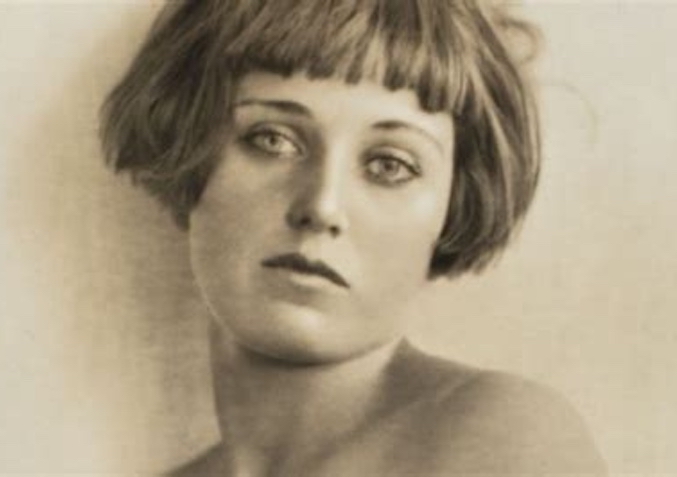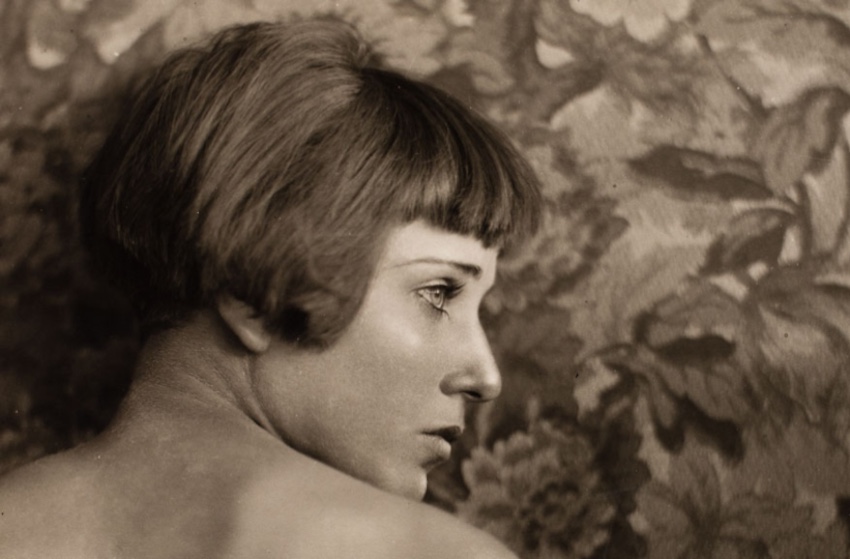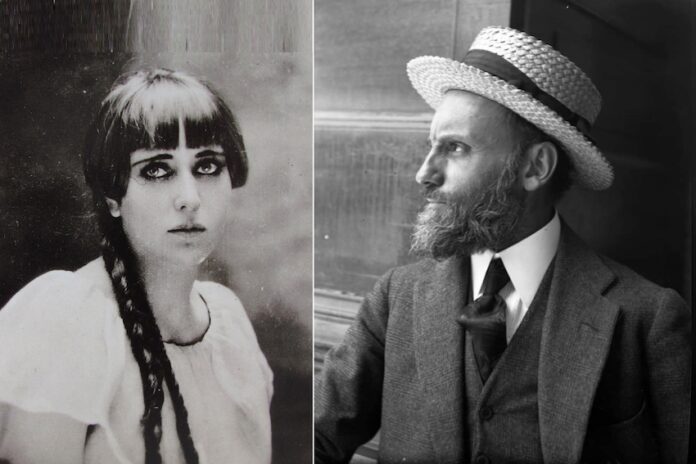It’s the middle of the night. Artist Nahui Olin — a rare beauty with her tousled light hair and sharp green eyes — stands naked in front of her lover, revolver pointed at his chest. Dr. Atl, 18 years her senior and likely covered in Atlcolor, the pigment he had invented about five years earlier, leaps from bed to grab her arm. The gun’s barrel points downward, and in her all-consuming rage, she fires five shots into the floor.
What happens next is anyone’s guess. Perhaps a roaring fight, perhaps a passionate reconciliation. What we do know is that this wouldn’t be the final straw for one of the Mexican art world’s most tempestuous couples — Dr. Atl and Olin’s five-year affair would be one of extreme highs and lows, leaving a lasting mark on Mexican society.

The cosmic meeting: When green eyes met water
In July 1922, Dr. Atl wrote in his diary. “In the midst of the swaying crowd…a green abyss opened before me like the sea…the eyes of a woman. I fell into this abyss, instantly,” he mused.
He was Gerardo Murillo, an artist, activist, scholar and volcanologist from Guadalajara in the throes of starting his own national art school in the Ex-Convento de la Merced, an abandoned colonial monastery in the center of Mexico City. She was Carmen Mondragón, an artist, painter and poet. She would also become Atl’s muse.
Their pairing would be profound in ways that extended beyond their immediate relationship, sparking debate about the new role of women in Mexico’s largely patriarchal society, and about the power people hold to shape their own identities.
Murillo studied art in Paris and Rome, changing his name to Dr. Atl in 1902 — “atl” means water in Nahuatl. His love for Mexico fully embedded him into Mexico’s political and cultural transformation leading up to the Revolution, even from abroad. In 1913, he returned to Mexico, settling permanently in Mexico City, where he was named Director of the Academy of San Carlos, nowadays part of the National Autonomous University of Mexico (UNAM).
He used this platform to promote national ideals and revolutionary expression among his students, mentoring the likes of Diego Rivera, José Clemente Orozco and David Alfaro Siqueiros and fostering the Mexican muralism movement that these three students of Dr. Atl’s would go on to create.

Curiously enough, the same year Dr. Atl returned to Mexico, Carmen left for Paris. When the Decena Trágica occurred — a military coup that overthrew President Madero and temporarily installed Victoriano Huerta in his place — many conservative aristocrats were exiled.
Carmen’s father, General Manuel Mondragón, inventor of the first semiautomatic rifle adopted by a national military, was one of these exiles. The family fled to Europe, eventually settling in Spain, and Carmen’s career as a painter began.
She and her husband at the time, a Mexican cadet whom she married in 1913, returned to Mexico City in 1921. Now deep in the art scene, Carmen attended an event at the Academy of San Carlos, where she’d catch the eye and heart of Dr. Atl.
The Monastery of Sin: Headquarters of societal rebellion
A now-divorced Carmen Mondragon moved into the monastery with Atl, where he would receive students at his national art school and Carmen would dive more deeply into her craft. She published her first poetry book painted vibrant portraits of herself and daily life and served as a nude model for Diego Rivera and Edward Weston. Together, the art world’s new power couple inspired the local community in forging a new Mexican identity; they also inspired each other’s artistic endeavors.
From the start, their relationship was volatile, fueled by dramatic arguments and even more over-the-top reconciliations. In 1922, Dr. Atl christened Mondragon with the name “Nahui Olin”, a Nahuatl name for the “power with which the sun makes the planets turn,” a nod to her forceful nature.
But as time went on and more female students visited the monastery, Olin’s jealousy grew. She frequently accused him of infidelity — an act of which she was probably also guilty — and she didn’t bother to hide her eruptions from the public.
On one occasion, she allegedly tried to push two young female visitors to the monastery off a balcony; on another, she hung notes on Atl’s door for all the neighbors to see, denouncing him for sleeping with other women. In 1923, just two years into their torrid relationship, the newspaper El Universal Ilustrado published an interview with the couple, an article that was known at the time as the “Public Marriage Debate.”
In that article, the following quotes were published:
“I consider marriage a fundamentally absurd aspect of society…life with a literary woman would be a constant catastrophe” — Dr. Atl
“She would never marry a man,” El Universal told its readers. “And even less an extravagant painter or a mediocre writer,” Olin told the newspaper, “because they are already married to the obsession of glory… They are husbands to vanity.” — Nahui Olin
Separate studios: The unraveling of two worlds

Perhaps shocking to no one, the relationship didn’t last. Olin eventually moved to her own apartment in a building’s maid’s quarters, supporting herself through modeling and as an art teacher in the public school system. An entrepreneur at heart, she organized gallery openings to showcase her work — in 1928, she infamously hosted an exhibit of her nude photos and invited the most elite members of society, including Mexico’s Minister of Finance and the Minister of Education, who both gladly attended.
Olin continued posing nude into the 1930s for money and published several books of poetry and prose. She immersed herself in music, learning to play the piano and compose scores, though this proved more an emotional than a lucrative outlet. She managed to scrape by, but with the passage of years became more reclusive, selling her nude photos in San Juan de Letrán and feeding the neighborhood cats. She would eventually die alone, penniless, in her family home in Tacubaya in 1978.
Following their split, Dr. Atl turned his focus once again to studying and painting central Mexico’s volcanoes. In 1943, while observing Michoacán’s erupting Paricutín, he was caught in a flow of hot lava and toxic gas that resulted in the amputation of his right leg.
Despite the life-altering injury, the increasingly eccentric artist would continue writing, researching, painting and lecturing until his death in 1964. There is no published evidence that Dr. Atl commented on Olin, or vice versa, after their breakup.
The creative revolution they began
Atl and Olin’s partnership became emblematic of the avant-garde spirit that swept through Mexico City’s cultural elite in the 1920s. By openly rejecting traditional norms about marriage, gender and artistic roles, they challenged rigid expectations in Mexican culture, sparking debate about the need for personal freedom and creative autonomy. Their artistic collaboration in painting, poetry, essays and their public scandals all helped push the boundaries of Mexican modernism.
And Atl’s open support of Olin’s creative independence — including her nude modeling — pushed a new narrative: that female artists were intellectually equal to males and commanded agency in contemporary art.
That revolver Olin fired into the monastery floor may have signaled a moment of jealousy but before their final breakup, Olin and Atl’s project of love, art and rebellion was an inseparable force in shaping an emerging postrevolutionary Mexico.
Bethany Platanella is a travel planner and lifestyle writer based in Mexico City. She lives for the dopamine hit that comes directly after booking a plane ticket, exploring local markets, practicing yoga and munching on fresh tortillas. Sign up to receive her Sunday Love Letters to your inbox, peruse her blog or follow her on Instagram.
